Abstract
The selectively toxic effect of nitroimidazole drugs towards anaerobic bacteria and protozoa depends on a number of factors. The killing action of such drugs as metronidazole requires the reduction of the nitro group, a process which influences the rate of entry of the drug into the susceptible cell and which is determined by mechanisms involving ferredoxin-linked (or the equivalent) reactions in the cell. The reduced agent subsequently causes strand breakage of DNA, the extent of which depends on the A + T content of the DNA. Other effects of such drugs may include the possible inhibition of DNA repair mechanisms which exacerbate DNA damage, Inhibition of activity of nitroimidazoles may be caused by aminothiol radical scavengers and radioprotectors normally present in the cell or by the presence of other organisms in the environment (that is, the vagina) capable of inactivating the drugs.
Full text
PDF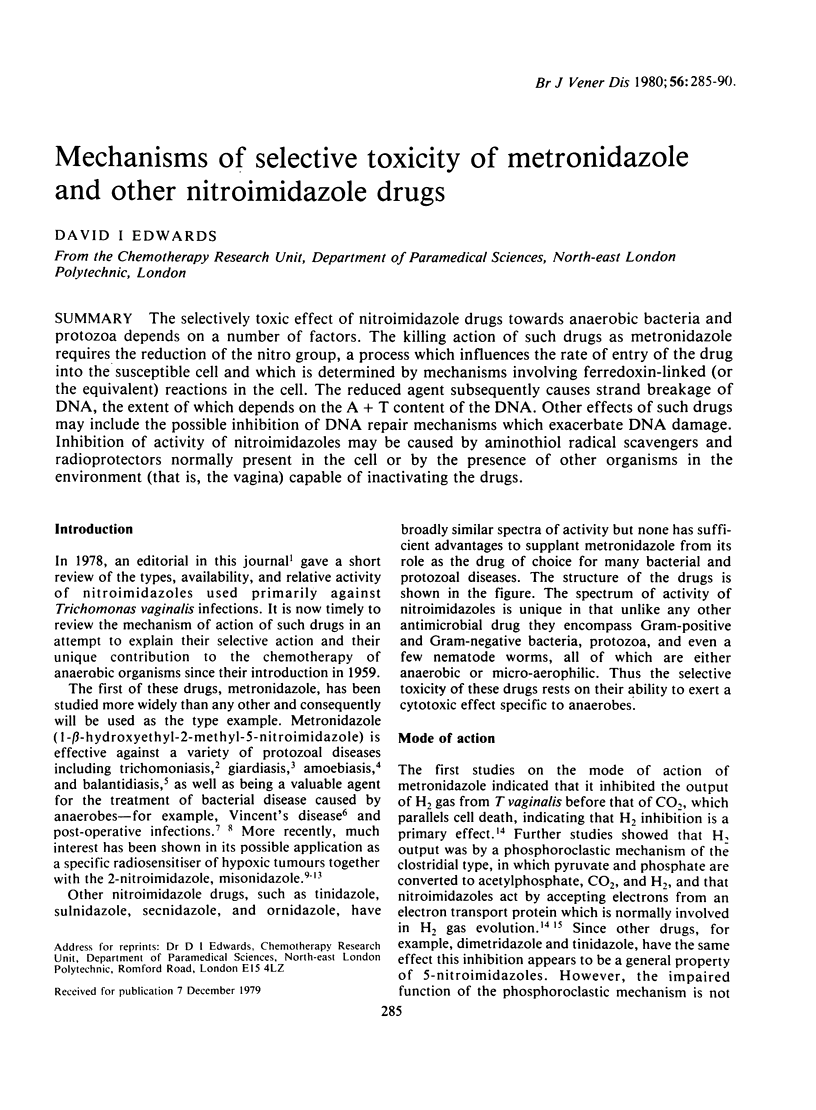
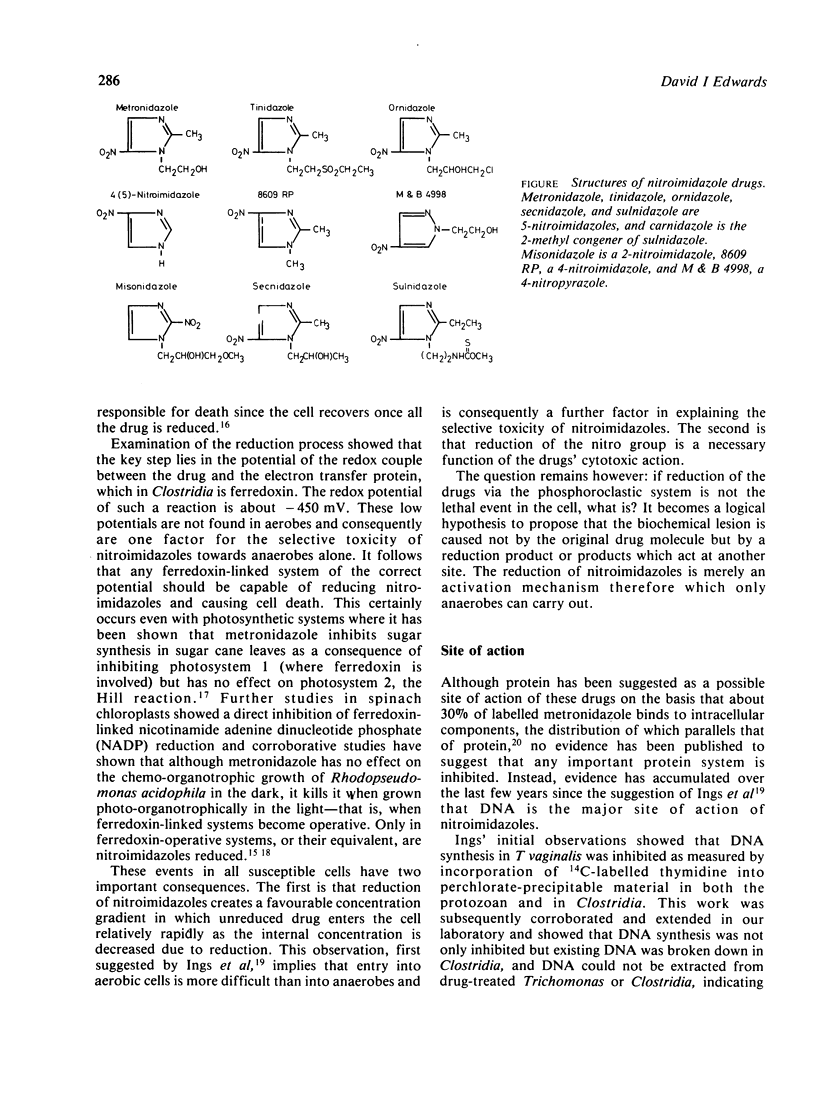
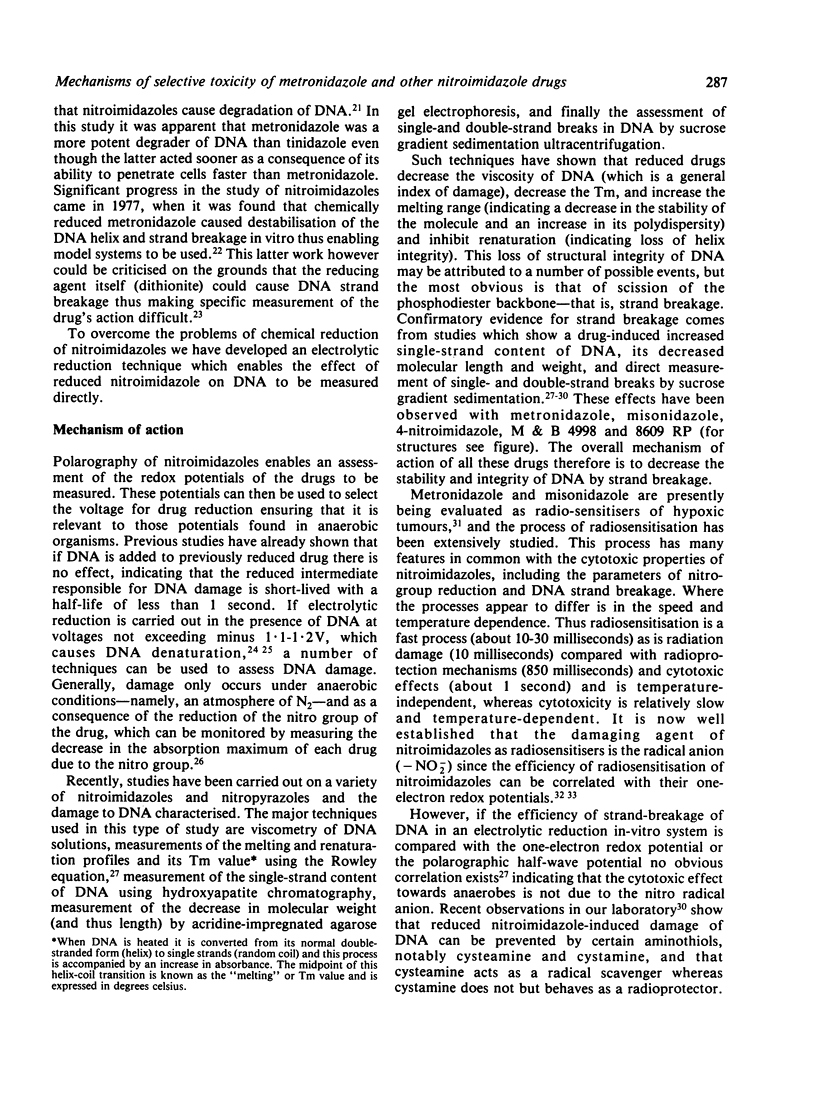
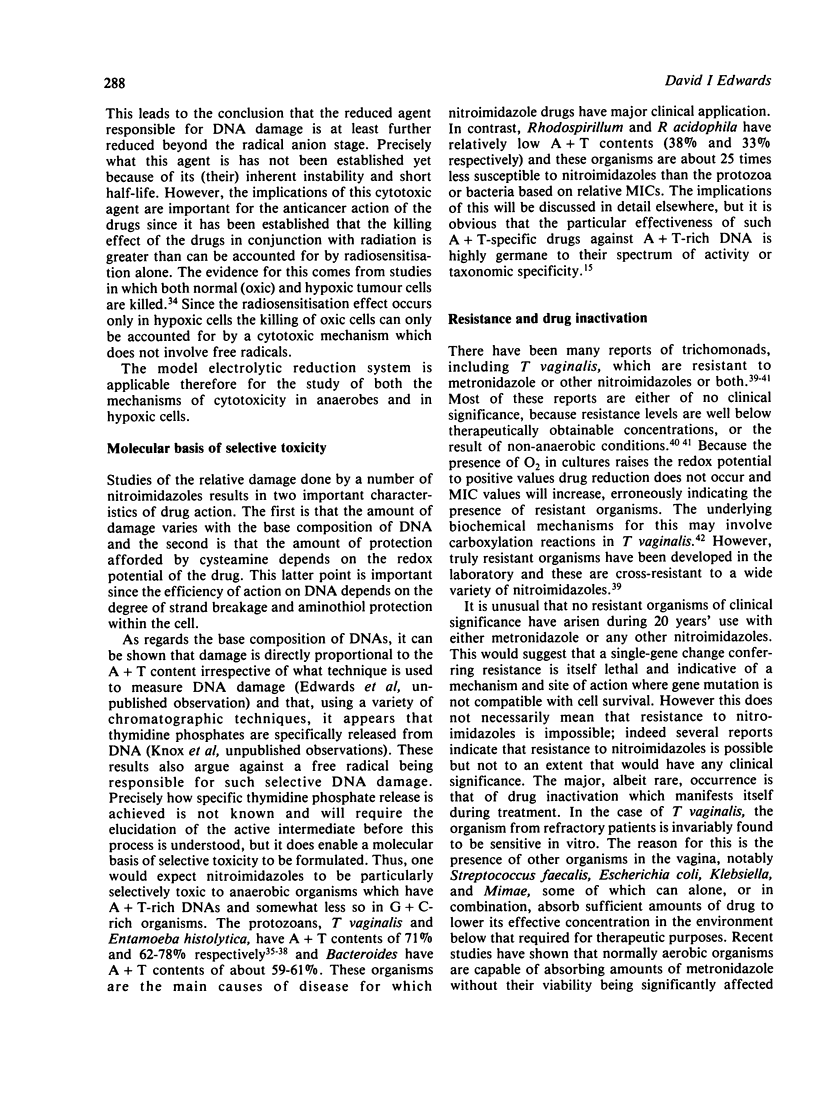
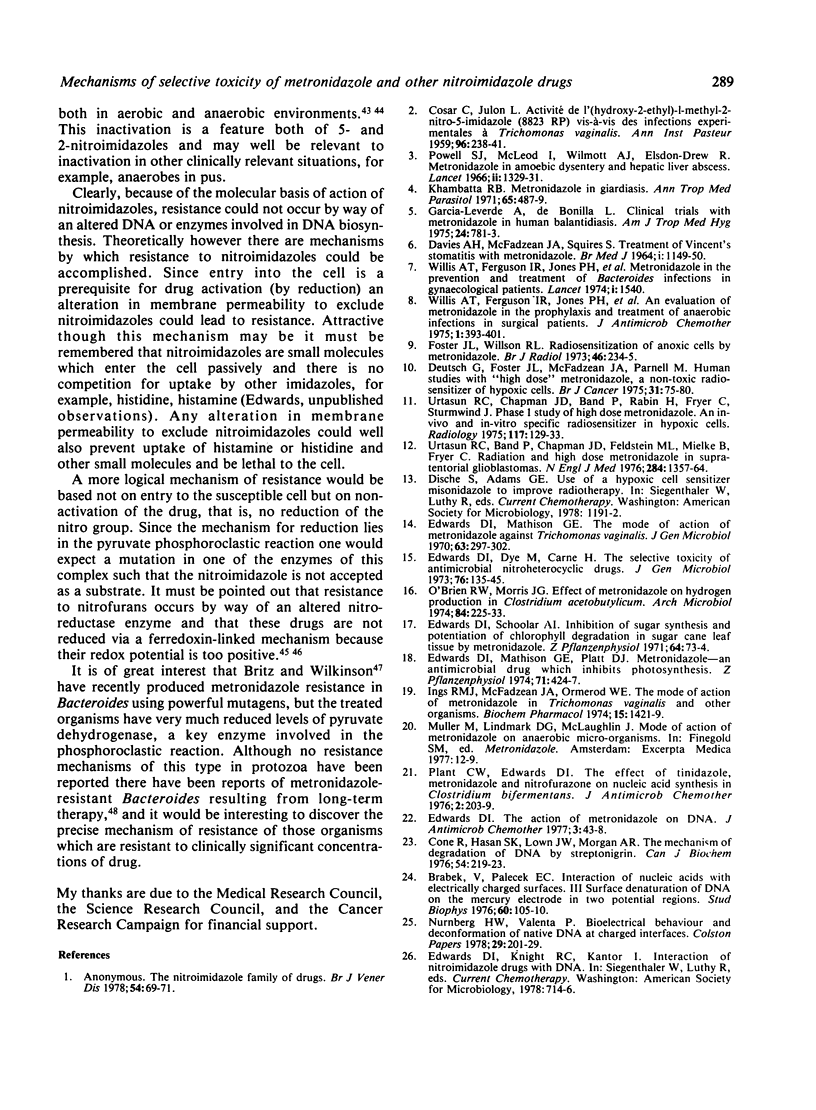
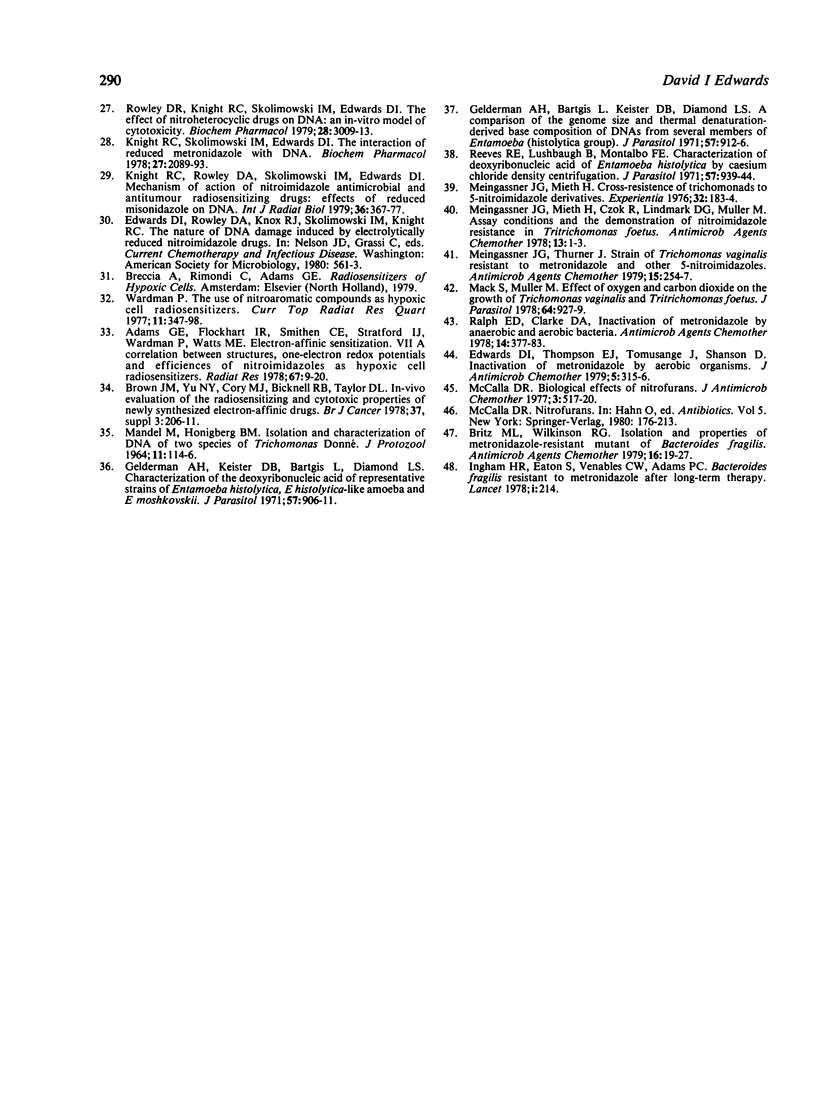
Selected References
These references are in PubMed. This may not be the complete list of references from this article.
- Adams G. E., Flockhart I. R., Smithen C. E., Stratford I. J., Wardman P., Watts M. E. Electron-affinic sensitization. VII. A correlation between structures, one-electron reduction potentials, and efficiencies of nitroimidazoles as hypoxic cell radiosensitizers. Radiat Res. 1976 Jul;67(1):9–20. [PubMed] [Google Scholar]
- An evaluation of metronidazole in the prophylaxis and treatment of anaerobic infections in surgical patients. J Antimicrob Chemother. 1975 Dec;1(4):393–341. doi: 10.1093/jac/1.4.393. [DOI] [PubMed] [Google Scholar]
- Britz M. L., Wilkinson R. G. Isolation and properties of metronidazole-resistant mutants of Bacteroides fragilis. Antimicrob Agents Chemother. 1979 Jul;16(1):19–27. doi: 10.1128/aac.16.1.19. [DOI] [PMC free article] [PubMed] [Google Scholar]
- Brown J. M., Yu N. Y., Cory M. J., Bicknell R. B., Taylor D. L. In vivo evaluation of the radiosensitizing and cytotoxic properties of newly synthesized electron-affinic drugs. Br J Cancer Suppl. 1978 Jun;3:206–211. [PMC free article] [PubMed] [Google Scholar]
- COSAR C., JULOU L. Activité de l'(hydroxy-2'éthyl)-1 méthyl-2 nitro-5 imidazole (8.823 R. P.) vis-à-vis des infections expérimentales à Trichomonas vaginalis. Ann Inst Pasteur (Paris) 1959 Feb;96(2):238–241. [PubMed] [Google Scholar]
- Cone R., Hasan S. K., Lown J. W., Morgan A. R. The mechanism of the degradation of DNA by streptonigrin. Can J Biochem. 1976 Mar;54(3):219–223. doi: 10.1139/o76-034. [DOI] [PubMed] [Google Scholar]
- DAVIES A. H., MCFADZEAN J. A., SQUIRES S. TREATMENT OF VINCENT'S STOMATITIS WITH METRONIDAZOLE. Br Med J. 1964 May 2;1(5391):1149–1150. doi: 10.1136/bmj.1.5391.1149. [DOI] [PMC free article] [PubMed] [Google Scholar]
- Deutsch G., Foster J. L., McFadzean J. A., Parnell M. Human studies with "high dose" metronidazole: a non-toxic radiosensitizer of hypoxic cells. Br J Cancer. 1975 Jan;31(1):75–80. doi: 10.1038/bjc.1975.9. [DOI] [PMC free article] [PubMed] [Google Scholar]
- Edwards D. I., Dye M., Carne H. The selective toxicity of antimicrobial nitroheterocyclic drugs. J Gen Microbiol. 1973 May;76(1):135–145. doi: 10.1099/00221287-76-1-135. [DOI] [PubMed] [Google Scholar]
- Edwards D. I., Mathison G. E. The mode of action of metronidazole against Trichomonas vaginalis. J Gen Microbiol. 1970 Nov;63(3):297–302. doi: 10.1099/00221287-63-3-297. [DOI] [PubMed] [Google Scholar]
- Edwards D. I. The action of metronidazole on DNA. J Antimicrob Chemother. 1977 Jan;3(1):43–48. doi: 10.1093/jac/3.1.43. [DOI] [PubMed] [Google Scholar]
- Edwards D. I., Thompson E. J., Tomusange J., Shanson D. Inactivation of metronidazole by aerobic organisms. J Antimicrob Chemother. 1979 May;5(3):315–316. doi: 10.1093/jac/5.3.315. [DOI] [PubMed] [Google Scholar]
- Foster J. L., Willson R. L. Radiosensitization of anoxic cells by metronidazole. Br J Radiol. 1973 Mar;46(543):234–235. doi: 10.1259/0007-1285-46-543-234. [DOI] [PubMed] [Google Scholar]
- Garcia-Laverde A., de Bonilla L. Clinical trials with metronidazole in human balantidiasis. Am J Trop Med Hyg. 1975 Sep;24(5):781–783. doi: 10.4269/ajtmh.1975.24.781. [DOI] [PubMed] [Google Scholar]
- Gelderman A. H., Bartgis I. L., Keister D. B., Diamond L. S. A comparison of genome sizes and thermal-denaturation-derived base composition of DNAs from several members of Entamoeba (histolytica group). J Parasitol. 1971 Aug;57(4):912–916. [PubMed] [Google Scholar]
- Gelderman A. H., Keister D. B., Bartgis I. L., Diamond L. S. Characterization of the deoxyribonucleic acid of representative strains of Entamoeba histolytica, E. histoytica-like amebae, and E. moshkovskii. J Parasitol. 1971 Aug;57(4):906–911. [PubMed] [Google Scholar]
- Ingham H. R., Eaton S., Venables C. W., Adams P. C. Bacteroides fragilis resistant to metronidazole after long-term therapy. Lancet. 1978 Jan 28;1(8057):214–214. doi: 10.1016/s0140-6736(78)90655-4. [DOI] [PubMed] [Google Scholar]
- Ings R. M., McFadzean J. A., Ormerod W. E. The mode of action of metronidazole in Trichomonas vaginalis and other micro-organisms. Biochem Pharmacol. 1974 May 1;23(9):1421–1429. doi: 10.1016/0006-2952(74)90362-1. [DOI] [PubMed] [Google Scholar]
- Khambatta R. B. Metronidazole in giardiasis. Ann Trop Med Parasitol. 1971 Dec;65(4):487–489. doi: 10.1080/00034983.1971.11686781. [DOI] [PubMed] [Google Scholar]
- Knight R. C., Rowley D. A., Skolimowski I., Edwards D. I. Mechanism of action of nitroimidazole antimicrobial and antitumour radiosensitizing drugs. Effects of reduced misonidazole on DNA. Int J Radiat Biol Relat Stud Phys Chem Med. 1979 Oct;36(4):367–377. doi: 10.1080/09553007914551151. [DOI] [PubMed] [Google Scholar]
- Knight R. C., Skolimowski I. M., Edwards D. I. The interaction of reduced metronidazole with DNA. Biochem Pharmacol. 1978;27(17):2089–2093. doi: 10.1016/0006-2952(78)90277-0. [DOI] [PubMed] [Google Scholar]
- MANDEL M., HONIGBERG B. M. ISOLATION AND CHARACTERIZATION OF DEOXYRIBONUCLEIC ACID OF TWO SPECIES OF TRICHOMONAS DONNE. J Protozool. 1964 Feb;11:114–116. doi: 10.1111/j.1550-7408.1964.tb01730.x. [DOI] [PubMed] [Google Scholar]
- Mack S. R., Müller M. Effect of oxygen and carbon dioxide on the growth of Trichomonas vaginalis and Tritrichomonas foetus. J Parasitol. 1978 Oct;64(5):927–929. [PubMed] [Google Scholar]
- McCalla D. R. Biological effects of nitrofurans. J Antimicrob Chemother. 1977 Sep;3(5):517–520. doi: 10.1093/jac/3.5.517. [DOI] [PubMed] [Google Scholar]
- Meingassner J. G., Mieth H. Cross-resistance of Trichomonads to 5-nitroimidazole-derivatives. Experientia. 1976 Feb 15;32(2):183–184. doi: 10.1007/BF01937754. [DOI] [PubMed] [Google Scholar]
- Meingassner J. G., Mieth H., Czok R., Lindmark D. G., Müller M. Assay conditions and the demonstration of nitroimidazole resistance in Tritrichomonas foetus. Antimicrob Agents Chemother. 1978 Jan;13(1):1–3. doi: 10.1128/aac.13.1.1. [DOI] [PMC free article] [PubMed] [Google Scholar]
- Meingassner J. G., Thurner J. Strain of Trichomonas vaginalis resistant to metronidazole and other 5-nitroimidazoles. Antimicrob Agents Chemother. 1979 Feb;15(2):254–257. doi: 10.1128/aac.15.2.254. [DOI] [PMC free article] [PubMed] [Google Scholar]
- O'Brien R. W., Morris J. G. Effect of metronidazole on hydrogen production by Clostridium acetobutylicum. Arch Mikrobiol. 1972;84(3):225–233. doi: 10.1007/BF00425200. [DOI] [PubMed] [Google Scholar]
- Plant C. W., Edwards D. I. Effect of tinidazole, metronidazole and nitrofurazone on nucleic acid synthesis in Clostridium bifermentans. J Antimicrob Chemother. 1976 Jun;2(2):203–209. doi: 10.1093/jac/2.2.203. [DOI] [PubMed] [Google Scholar]
- Powell S. J., MacLeod I., Wilmot A. J., Elsdon-Dew R. Metronidazole in amoebic dysentery and amoebic liver abscess. Lancet. 1966 Dec 17;2(7477):1329–1331. doi: 10.1016/s0140-6736(66)92081-2. [DOI] [PubMed] [Google Scholar]
- Ralph E. D., Clarke D. A. Inactivation of metronidazole by anaerobic and aerobic bacteria. Antimicrob Agents Chemother. 1978 Sep;14(3):377–383. doi: 10.1128/aac.14.3.377. [DOI] [PMC free article] [PubMed] [Google Scholar]
- Reeves R. E., Lushbaugh T. S., Montalvo F. E. Characterization of deoxyribonucleic acid of Entamoeba histolytica by cesium chloride density centrifugation. J Parasitol. 1971 Oct;57(5):939–944. [PubMed] [Google Scholar]
- Rowley D. A., Knight R. C., Skolimowski I. M., Edwards D. I. The effect of nitroheterocyclic drugs on DNA: an in vitro model of cytotoxicity. Biochem Pharmacol. 1979 Oct 1;28(19):3009–3013. doi: 10.1016/0006-2952(79)90601-4. [DOI] [PubMed] [Google Scholar]
- Urtasun R. C., Chapman J. D., Band P., Rabin H. R., Fryer C. G., Sturmwind J. Phase 1 study of high-dose metronidazole: a specific in vivo and in vitro radiosensitizer of hypoxic cells. Radiology. 1975 Oct;117(1):129–133. doi: 10.1148/117.1.129. [DOI] [PubMed] [Google Scholar]
- Wardman P. The use of nitroaromatic compounds as hypoxic cell radiosensitizers. Curr Top Radiat Res Q. 1977 Aug;11(4):347–398. [PubMed] [Google Scholar]


